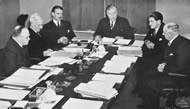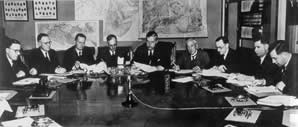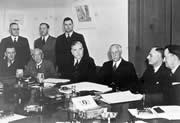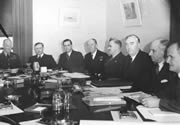
The War Cabinet
Two weeks after the outbreak of World War Two, on 15 September 1939, Prime Minister Menzies announced the formation of a War Cabinet, which was to become Australia’s main decision-making body on the conduct of the war. The inaugural meeting of the War Cabinet was held on 27 September 1939 at Victoria Barracks in Melbourne, in a room at the rear of the first floor of the northern wing, which had been completed in 1916 as an addition to the main building (A Block) on St Kilda Road.
The Cabinet minutes of 26 September 1939 record:
It was agreed that the War Cabinet, which should include such Ministers as the Prime Minister should direct, together with such Ministers as from time to time were coopted, should deal with all matters in relation to the conduct of the war other than matters of major policy. Matters of major policy should be determined by the full Cabinet. 1
Originally a standing committee of the full Cabinet, it was anticipated that the War Cabinet would be an executive subcommittee of that body. However, the War Cabinet increased in authority and stature as the war progressed and there was a tendency for these roles to be reversed. Major decisions on the conduct of the war were made by the War Cabinet, with the Full Cabinet dealing with more peripheral issues. War Cabinet meetings were held at Victoria Barracks, Melbourne, and in the Cabinet room adjacent to the prime ministerial suite at Parliament House, Canberra.
First meeting of the Australian War Cabinet, 27
September 1939.
Australian War Memorial: ID 042822
Minutes of first War Cabinet meeting on 27
September 1939. The minutes are signed by Frederick Shedden and
Prime Minister Menzies.
National Archives of Australia: A5954, 803/1
At the general election of September 1940 Menzies retained power only with the support of two independents, which prompted him to ask John Curtin, the Labor opposition leader to join a national government. Curtin declined but suggested a War Council comprising members of the government and the opposition. Menzies agreed and the Advisory War Council was formed, meeting for the first time on 29 October of that year.
The Advisory War Council was chaired by the Prime Minister and included members of the War Cabinet, but in addition membership was extended to the Leader and three members of the Opposition. The work of both bodies included military strategy, armaments and munitions, aircraft production, transport, and railways.
When Curtin became Prime Minister in October 1941 it was agreed that the Advisory War Council’s decisions be automatically accepted as War Cabinet decisions, with the Council only referring some matters on to the War Cabinet. This meant that Council meetings in many respects replaced those of the War Cabinet, giving the Advisory War Council a very influential role in the proceedings of the war.
John Curtin Prime Ministerial Library. Records of the Curtin Family. Advisory War Council 1940. JCPML00376/71.
The first page of contents for volume 1 of the
Advisory War Council minutes gives an indication of the wide range
of items considered. Contents listed on this one page include:
relations with Japan; Naval defence; Australian publicity in the
United States; and the use of foreign languages on radio-telephone
services.
National Archives of Australia: A5954, 812/1
John Curtin Prime Ministerial Library. Records of the Curtin Family. Inaugural meeting of the Advisory War Council, 28 October 1940. JCPML00376/131
Federal Government structure - This diagram shows the relationship between the Governor-General, the two houses of Parliament (the Senate and the House of Representatives) and the Prime Minister and gives the composition of the Cabinet, War Cabinet, and Advisory War Council. 2
'A tremendous degree of responsibility'
James Maher was a clerical assistant in the Department of Munitions, Melbourne, from January 1942. As such he had to frequently deliver messages to members of the War Cabinet, and had a special pass to ensure his immediate entry into the Cabinet Room.
As would be appreciated, all meetings of the War Cabinet were of a crisis nature and as a consequence everyone involved in the process felt a tremendous degree of responsibility, from the Prime Minister himself down to a humble messenger such as myself … should it be guns, planes or ships, those were the decisions confronting Cabinet based upon information delivered by myself … I was either the bearer of good or bad news, often my minister Mr Makin said to me, ‘Jim your message lightened the heart of the prime minister today,’ such was the state of tension. 3
With a return to peace, the Advisory War Council was disbanded on 30 August 1945 while the last meeting of the War Cabinet was held on 18 December 1945.
Prime Minister Menzies and the
Australian War Cabinet, 1939
National Archives of Australia: A5954, 1299/2 Photo 2.
|
|
|
|||||
|
|
||||||

s.jpg)

s.jpg)

